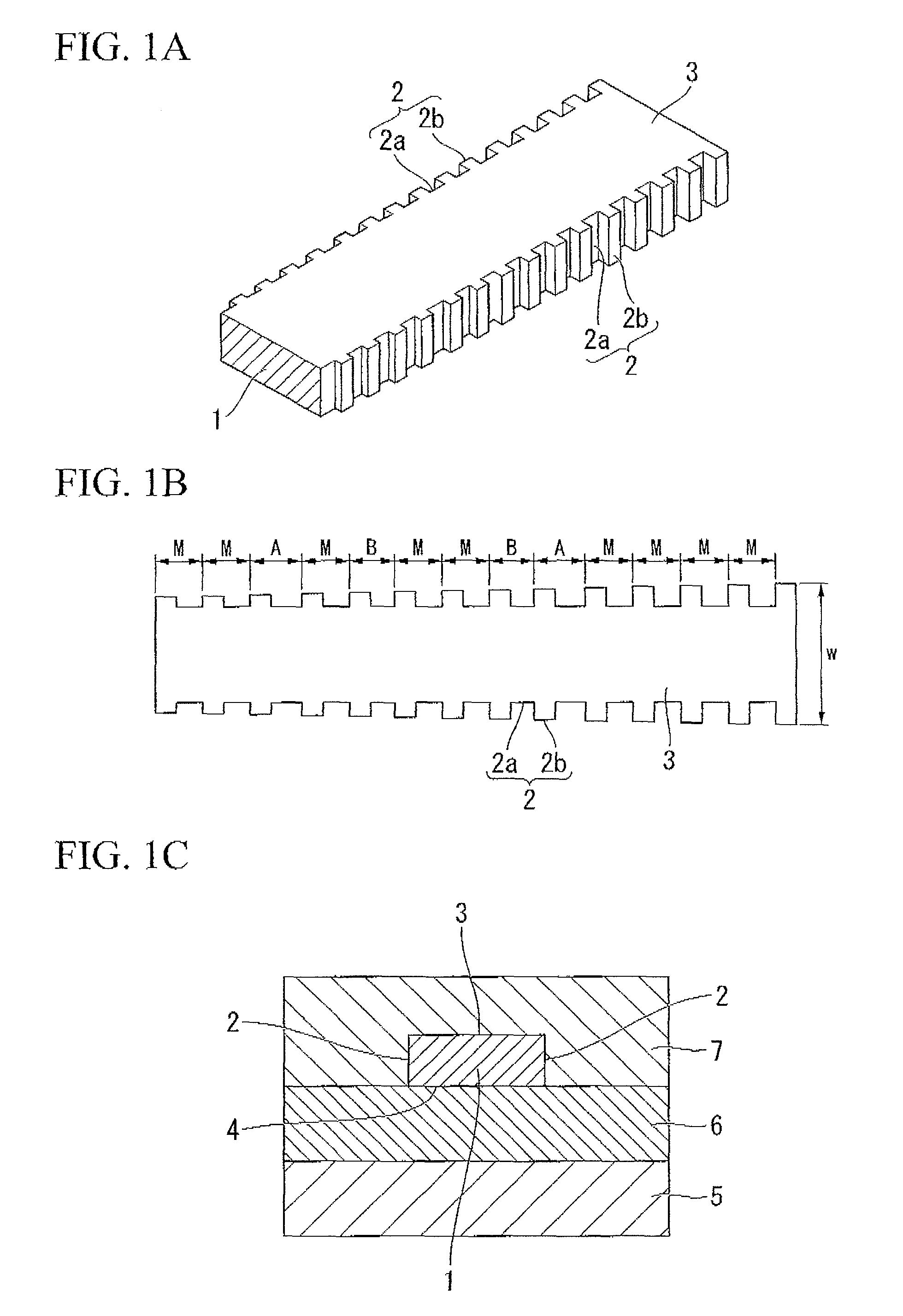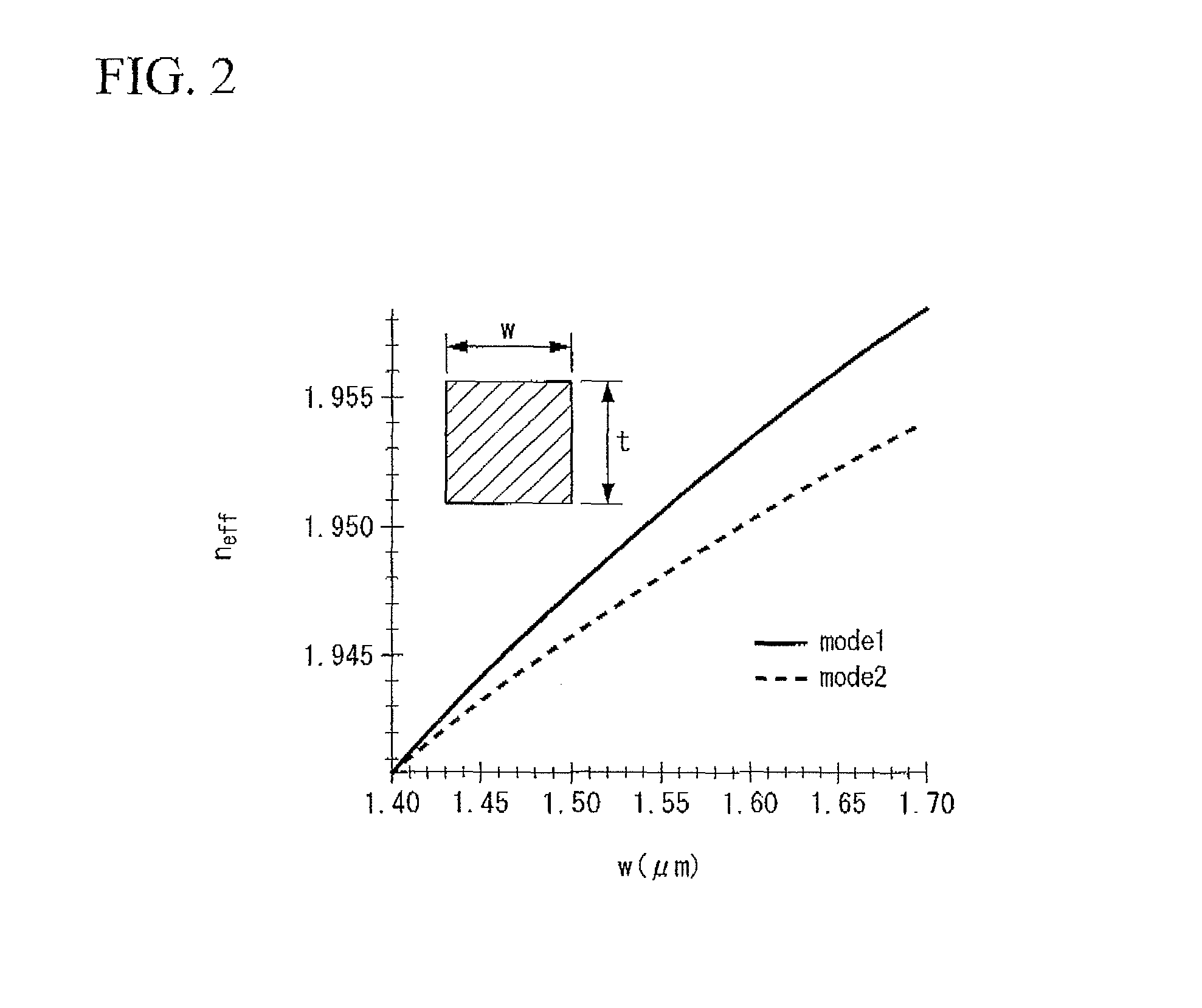Optical waveguide element, chromatic dispersion compensator, methods for designing chromatic dispersion compensator, optical filter, methods for designing optical filter, optical resonator and methods for designing optical resonator
a technology of chromatic dispersion compensator and optical waveguide element, which is applied in the direction of optical elements, multiplex communication, instruments, etc., to achieve the effect of reducing manufacturing cost, improving manufacturing yield, and easy tolerability control in the manufacturing process
- Summary
- Abstract
- Description
- Claims
- Application Information
AI Technical Summary
Benefits of technology
Problems solved by technology
Method used
Image
Examples
first embodiment
of an Optical Waveguide Element
[0173]A first exemplary embodiment of the optical waveguide element is shown in typical view in FIG. 1A through FIG. 1C. FIG. 1A is a perspective view of a portion of a core 1 of an optical waveguide, FIG. 1B is a plan view of the same portion of the core 1, and FIG. 1C is a cross-sectional view of an optical waveguide element. This optical waveguide element is a planar optical waveguide element in which an optical waveguide is formed on a substrate 5. The optical waveguide comprises a bottom cladding 6 which is formed on the substrate 5, a core 1 that is formed on the bottom cladding 6, and a top cladding 7 that is formed on the core 1 and on the bottom cladding 6. The grating structure comprises recessed portions 2a and protruding portions 2b that are formed in both side walls of the core 1 as periodical changes in the width w of the core 1. A top surface 3 and bottom surface 4 of the core 1 are flat.
[0174]In a high-function element such as a chromat...
second embodiment
of Optical Waveguide Element
[0191]An example of an optical waveguide element of the second embodiment of the present invention is shown in FIG. 3A through FIG. 3C. The optical waveguide element is a planar optical waveguide element in which an optical waveguide is located on the substrate. If the width or thickness of the waveguide in the light propagation direction is changed periodically in an optical waveguide, then the effective refractive index of the optical waveguide also changes periodically, and a Bragg grating can be constructed. In FIG. 3A through FIG. 3C, only the core 10 is shown and the claddings are not shown, however, it is to be assumed that cladding surrounds the periphery of the core 10. In addition, a substrate (not shown) is located below the cladding, and a bottom surface 14 of the core; 10 is parallel with the substrate surface. The term “horizontal direction” refers to a direction which is parallel to this substrate surface, and the term “vertical direction” ...
third embodiment
of an Optical Waveguide Element
[0216]An optical wave guide having a cross-sectional structure such as that shown in FIG. 7 can be given as an example of a Bragg grating optical waveguide structure in which polarization dependence has been reduced. On account of the simplified description of the principle of reducing polarization dependence, the cross-sectional structures of the cores 10 are all the same in, the planar optical waveguide elements of FIGS. 3A through 3C and FIGS. 6A through 6C. However, if the effective refractive index is changed by changing the dimensions of the optical waveguide, then an optical waveguide having a composite core structure such as that shown in FIG. 7 is preferable in order to improve the accuracy of the effective refractive index.
[0217]The core of the planar optical waveguide element 20 having the cross-sectional structure shown in FIG. 7 is a composite core formed by two areas, namely, inner side cores 21 and 22 and an outer side core 24.
[0218]In t...
PUM
| Property | Measurement | Unit |
|---|---|---|
| refractive index | aaaaa | aaaaa |
| grating length | aaaaa | aaaaa |
| grating length | aaaaa | aaaaa |
Abstract
Description
Claims
Application Information
 Login to View More
Login to View More - R&D
- Intellectual Property
- Life Sciences
- Materials
- Tech Scout
- Unparalleled Data Quality
- Higher Quality Content
- 60% Fewer Hallucinations
Browse by: Latest US Patents, China's latest patents, Technical Efficacy Thesaurus, Application Domain, Technology Topic, Popular Technical Reports.
© 2025 PatSnap. All rights reserved.Legal|Privacy policy|Modern Slavery Act Transparency Statement|Sitemap|About US| Contact US: help@patsnap.com



